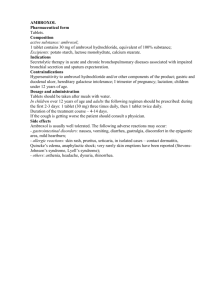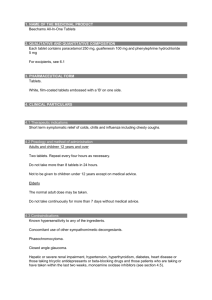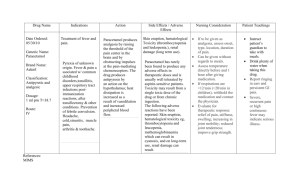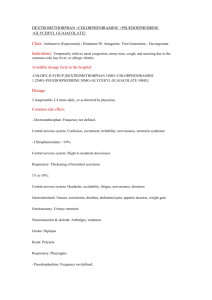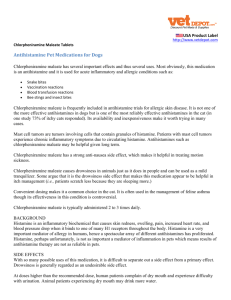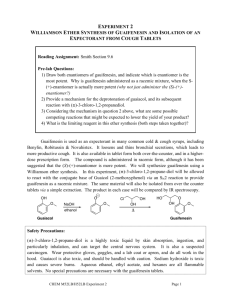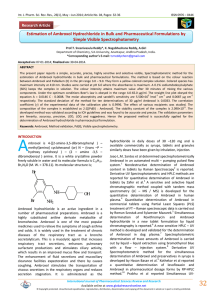Document 13309558
advertisement
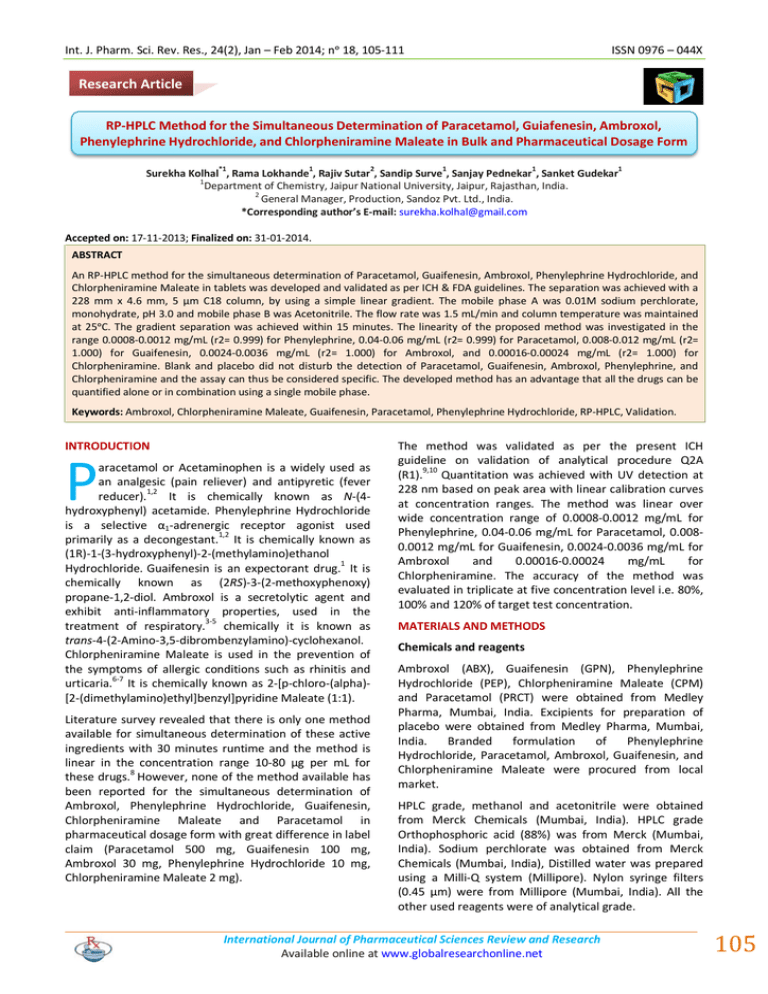
Int. J. Pharm. Sci. Rev. Res., 24(2), Jan – Feb 2014; nᵒ 18, 105-111 ISSN 0976 – 044X Research Article RP-HPLC Method for the Simultaneous Determination of Paracetamol, Guiafenesin, Ambroxol, Phenylephrine Hydrochloride, and Chlorpheniramine Maleate in Bulk and Pharmaceutical Dosage Form *1 1 2 1 1 1 Surekha Kolhal , Rama Lokhande , Rajiv Sutar , Sandip Surve , Sanjay Pednekar , Sanket Gudekar 1 Department of Chemistry, Jaipur National University, Jaipur, Rajasthan, India. 2 General Manager, Production, Sandoz Pvt. Ltd., India. *Corresponding author’s E-mail: surekha.kolhal@gmail.com Accepted on: 17-11-2013; Finalized on: 31-01-2014. ABSTRACT An RP-HPLC method for the simultaneous determination of Paracetamol, Guaifenesin, Ambroxol, Phenylephrine Hydrochloride, and Chlorpheniramine Maleate in tablets was developed and validated as per ICH & FDA guidelines. The separation was achieved with a 228 mm x 4.6 mm, 5 µm C18 column, by using a simple linear gradient. The mobile phase A was 0.01M sodium perchlorate, monohydrate, pH 3.0 and mobile phase B was Acetonitrile. The flow rate was 1.5 mL/min and column temperature was maintained at 25ᵒC. The gradient separation was achieved within 15 minutes. The linearity of the proposed method was investigated in the range 0.0008-0.0012 mg/mL (r2= 0.999) for Phenylephrine, 0.04-0.06 mg/mL (r2= 0.999) for Paracetamol, 0.008-0.012 mg/mL (r2= 1.000) for Guaifenesin, 0.0024-0.0036 mg/mL (r2= 1.000) for Ambroxol, and 0.00016-0.00024 mg/mL (r2= 1.000) for Chlorpheniramine. Blank and placebo did not disturb the detection of Paracetamol, Guaifenesin, Ambroxol, Phenylephrine, and Chlorpheniramine and the assay can thus be considered specific. The developed method has an advantage that all the drugs can be quantified alone or in combination using a single mobile phase. Keywords: Ambroxol, Chlorpheniramine Maleate, Guaifenesin, Paracetamol, Phenylephrine Hydrochloride, RP-HPLC, Validation. INTRODUCTION P aracetamol or Acetaminophen is a widely used as an analgesic (pain reliever) and antipyretic (fever reducer).1,2 It is chemically known as N-(4hydroxyphenyl) acetamide. Phenylephrine Hydrochloride is a selective α1-adrenergic receptor agonist used primarily as a decongestant.1,2 It is chemically known as (1R)-1-(3-hydroxyphenyl)-2-(methylamino)ethanol Hydrochloride. Guaifenesin is an expectorant drug.1 It is chemically known as (2RS)-3-(2-methoxyphenoxy) propane-1,2-diol. Ambroxol is a secretolytic agent and exhibit anti-inflammatory properties, used in the treatment of respiratory.3-5 chemically it is known as trans-4-(2-Amino-3,5-dibrombenzylamino)-cyclohexanol. Chlorpheniramine Maleate is used in the prevention of the symptoms of allergic conditions such as rhinitis and urticaria.6-7 It is chemically known as 2-[p-chloro-(alpha)[2-(dimethylamino)ethyl]benzyl]pyridine Maleate (1:1). Literature survey revealed that there is only one method available for simultaneous determination of these active ingredients with 30 minutes runtime and the method is linear in the concentration range 10-80 µg per mL for these drugs.8 However, none of the method available has been reported for the simultaneous determination of Ambroxol, Phenylephrine Hydrochloride, Guaifenesin, Chlorpheniramine Maleate and Paracetamol in pharmaceutical dosage form with great difference in label claim (Paracetamol 500 mg, Guaifenesin 100 mg, Ambroxol 30 mg, Phenylephrine Hydrochloride 10 mg, Chlorpheniramine Maleate 2 mg). The method was validated as per the present ICH guideline on validation of analytical procedure Q2A (R1).9,10 Quantitation was achieved with UV detection at 228 nm based on peak area with linear calibration curves at concentration ranges. The method was linear over wide concentration range of 0.0008-0.0012 mg/mL for Phenylephrine, 0.04-0.06 mg/mL for Paracetamol, 0.0080.0012 mg/mL for Guaifenesin, 0.0024-0.0036 mg/mL for Ambroxol and 0.00016-0.00024 mg/mL for Chlorpheniramine. The accuracy of the method was evaluated in triplicate at five concentration level i.e. 80%, 100% and 120% of target test concentration. MATERIALS AND METHODS Chemicals and reagents Ambroxol (ABX), Guaifenesin (GPN), Phenylephrine Hydrochloride (PEP), Chlorpheniramine Maleate (CPM) and Paracetamol (PRCT) were obtained from Medley Pharma, Mumbai, India. Excipients for preparation of placebo were obtained from Medley Pharma, Mumbai, India. Branded formulation of Phenylephrine Hydrochloride, Paracetamol, Ambroxol, Guaifenesin, and Chlorpheniramine Maleate were procured from local market. HPLC grade, methanol and acetonitrile were obtained from Merck Chemicals (Mumbai, India). HPLC grade Orthophosphoric acid (88%) was from Merck (Mumbai, India). Sodium perchlorate was obtained from Merck Chemicals (Mumbai, India), Distilled water was prepared using a Milli-Q system (Millipore). Nylon syringe filters (0.45 µm) were from Millipore (Mumbai, India). All the other used reagents were of analytical grade. International Journal of Pharmaceutical Sciences Review and Research Available online at www.globalresearchonline.net 105 Int. J. Pharm. Sci. Rev. Res., 24(2), Jan – Feb 2014; nᵒ 18, 105-111 Selection of UV wavelength 10ppm solution of each Phenylephrine Hydrochloride, Paracetamol, Guaifenesin, Ambroxol and Chlorpheniramine Maleate was prepared separately in methanol. UV scan of the above solutions were carried out over a wavelength range of 200–400 nm by using the Shimadzu UV spectrophotometer, Model- UV-1800. The detection wavelength was set at 228 nm because all the components had higher responses. An overlaid UV absorption spectrum is shown in Figure 1. ISSN 0976 – 044X For test sample solution, 10 tablets were weighed and crushed to a fine powder. Powder equivalent to one tablet (containing Paracetamol 500 mg, Guaifenesin 100 mg, Ambroxol 30 mg, Phenylephrine Hydrochloride 10 mg, Chlorpheniramine Maleate 2 mg) was accurately weighed and transferred into a 100 mL volumetric flask. Added 70mL diluent, and then the contents of the volumetric flask were sonicated for 15 min to enable complete dissolution of analytes. Then volume was made up to 100 mL with diluent. The solution was filtered through 0.45 µm filters and the 1 mL of this filtrate was further diluted to 100 mL with diluent. 10 µL of these solutions were injected into the HPLC system and the peak area was recorded from the respective chromatogram. Calculation All active ingredients were quantified with the following calculation: Sample Area x Standard dilution factor x 100 % Assay = --------------------------------------------------------Standard area x Sample dilution factor Figure 1: Overlaid UV absorption spectrum of Phenylephrine Hydrochloride, Paracetamol, Guaifenesin, Ambroxol and Chlorpheniramine Maleate. HPLC instruments and analytical conditions Chromatographic separation was achieved using HPLC System (Waters Alliance 2695 Separation Module) containing binary solvent manager, an autosampler and UV detector. The output signal was monitored and processed using Empower software. An Inertsil C18 column (250 mm X 4.6 mm id and 5 µm particle size) was used as the stationary phase. Mobile phase consisting of Mobile phase A: buffer (0.01 M Sodium perchlorate. Monohydrate pH 3.0 with OPA) and Mobile Phase B: Acetonitrile with simple gradient program (0-10 min:: MP-A : 95-40; 10-12 min :: MP-A : 4095; 12-15min :: MP-A : 95-95) was delivered at a flow rate of 1.5 mL/min. The mobile phase was filtered through a 0.45 µ membrane filter and sonicated for 15 min. The column temperature was kept at 25°C. The detector was set at the wavelength of 228 nm. Injection volume kept was 10 µL. RESULTS AND DISCUSSION Literature survey revealed that, no method is available in the official compendia using HPLC for analyzing Phenylephrine Hydrochloride, Paracetamol, Guaifenesin, Ambroxol and Chlorpheniramine Maleate in dosage forms. The present proposed method was compared with the reported method in the literature and comparison is shown in Table 1. The complete separation of the analytes was accomplished in less than 15 min and the method can be successfully applicable to perform routine analysis of Phenylephrine Hydrochloride, Paracetamol, Guaifenesin, Ambroxol and Chlorpheniramine Maleate in bulk and in commercially available dosage forms. Method Validation The developed RP-HPLC method was validated as per International Conference on Harmonization (ICH) guideline, VALIDATION OF ANALYTICAL PROCEDURES: Q2 (R1), for the parameters like system suitability, linearity and range, precision (repeatability), intermediate precision (ruggedness), specificity, accuracy and robustness. Solutions and sample preparation System suitability For the system suitability test, the solution containing 0.001 mg/mL PEP, 0.05 mg/mL of PRCT, 0.01 mg/mL of GPN, 0.003 mg/mL of ABX and 0.0002 mg/mL of CPM was prepared in diluent containing Acetonitrile and water (5:5 v/v). The system suitability test performed according to USP36.11 The standard solution was injected six times and results were recorded to find the adequate peak separation (resolution), percentage relative standard deviation for area and retention time, peak asymmetry and theoretical plates. The results obtained were compiled in Table 2. For the linearity studies, a standard stock solution containing 0.1 mg/mL PEP, 5.0 mg/mL of PRCT, 1.0 mg/mL of GPN, 0.3 mg/mL of ABX and 0.02 mg/mL of CPM was prepared by diluent and diluted with the same solvent to yield solutions at different concentration. International Journal of Pharmaceutical Sciences Review and Research Available online at www.globalresearchonline.net 106 Int. J. Pharm. Sci. Rev. Res., 24(2), Jan – Feb 2014; nᵒ 18, 105-111 ISSN 0976 – 044X Table 1: Comparison of the performance characteristics of the present method with the published methods Method Reagents Detection Wavelength/ Runtime Linearity (mg/mL) Remark Reference HPLC Ammonium acetate, Acetonitrile 220 nm / 30 min 0.01 to 0.08 mg/mL for all components. Very narrow linearity range [8] HPLC Sodium perchlorate, Acetonitrile 228 nm / 15 min 0.0008-0.0012 mg/mL for PEP, 0.04-0.06 mg/mL for PRCT, 0.008- 0.0012 mg/mL for GPN, 0.0024-0.0036 mg/mL for ABX and 0.00016-0.00024 mg/mL for CPM Wide linearity range Present work Table 2: System suitability Reference solution Peak Area, for n=6 Phenylephrine Paracetamol Guaifenesin Ambroxol Chlorpheniramine 1.33 0.65 0.82 1.15 0.78 0.20 0.23 7.48 2.86 1.11 1.30 6405 5829 % RSD Acceptance Criteria Not more than 2.0% Reference solution Peak retention time (min,) for n=6 % RSD 0.11 0.11 Acceptance Criteria 0.12 Not more than 1.0% Reference solution Peak resolution, for n=6 Resolution - 2.20 Acceptance Criteria 2.33 Not less than 2.0 Reference solution Peak Symmetry factor, for n=6 Symmetry Factor 1.07 1.06 Acceptance Criteria 1.07 Should be between 0.8 – 1.2 Reference solution Peak Theoretical plates, for n=6 Theoretical plates 5383 4939 Acceptance Criteria 5974 Not less than 2000 Table 3: Precision and Intermediate Precision results Phenylephrine Paracetamol Guaifenesin Ambroxol Chlorpheniramine Average Assay (%) 101.61 99.58 98.41 100.81 100.97 % RSD 0.13 0.29 0.33 0.44 0.57 Precision (Day 1) –Assay % Intermediate Precision (Day 2) – Assay % Average 99.77 99.27 99.93 99.99 99.15 % RSD 0.69 0.27 0.41 0.85 0.85 Average for Precision and Intermediate Precision 100.69 99.43 99.17 100.40 100.06 % RSD for Precision and Intermediate Precision 1.07 0.31 0.88 0.77 1.17 Acceptance Criteria % RSD should not be more than 2.0% for day-1 and day-2. Results Specificity It was observed that limits for percentage standard deviation for peak area`s and retention time for individual analyte, as well as resolution, symmetry factor and theoretical plates for all individual analytes are within the limit, which shows that the method have good system suitability. Specificity was performed to detect the presence of interference peak (blank and placebo peaks) at the retention time of the analyte peak. The specificity of the method was checked by comparison of chromatograms obtained from test sample solution and the corresponding placebo. The interference of placebo was detected by preparing placebo solution equivalent to about the weight in proportion of tablet preparation as International Journal of Pharmaceutical Sciences Review and Research Available online at www.globalresearchonline.net 107 Int. J. Pharm. Sci. Rev. Res., 24(2), Jan – Feb 2014; nᵒ 18, 105-111 per the test method and was injected into the HPLC system. The interference of blank was detected by injecting diluent as per the test method. The representative chromatogram obtained for Phenylephrine Hydrochloride, Paracetamol, Guaifenesin, Ambroxol and Chlorpheniramine Maleate is shown in Figure 2. Paracetamol, Guaifenesin, Chlorpheniramine. ISSN 0976 – 044X Ambroxol and Precision and Ruggedness (Intermediate precision) Method precision was evaluated by carrying out six different test sample solution preparation. Different analyst from the same laboratory evaluated the intermediate precision of the method. The assay of these samples was determined. Precision and intermediate precision of the method was evaluated by calculating the %RSD. The values were given in Table 3. Results Percentage Relative standard deviation (%RSD) obtained was found to be less than 2% for day 1 and day 2. Linearity and range Figure 2: Typical Chromatograms of Standard Solution containing Phenylephrine, Paracetamol, Guaifenesin, Ambroxol and Chlorpheniramine Results No interference from diluent, excipients or any other peak was found at the retention time of Phenylephrine, The linearity of detector response was determined by preparing a series of solution of the working standards (mixture of all active ingredients) over the range of 80% to 120% of targeted concentration. These solutions were injected into the chromatographic system and response area was recorded. Calibration curve was constructed by plotting area against concentration and regression equation was computed. The linearity plots with values were shown in Figure 3. Figure 3: Calibration curves of Phenylephrine, Paracetamol, Guaifenesin, Ambroxol and Chlorpheniramine showing linearity Results: The correlation coefficient values were within the limit 0.998 and Y-intercept values were within ± 2 %. International Journal of Pharmaceutical Sciences Review and Research Available online at www.globalresearchonline.net 108 Int. J. Pharm. Sci. Rev. Res., 24(2), Jan – Feb 2014; nᵒ 18, 105-111 ISSN 0976 – 044X Table 4: Accuracy (Recovery) Active Ingredient Name Phenylephrine Paracetamol Guaifenesin Ambroxol Chlorpheniramine Concentration (%) Amount Added (mg/mL) Amount found (mg/mL)* Mean Recovery (%)** 80 0.0008022 0.0008018 100.1 100 0.0010027 0.0010154 98.8 120 0.0012033 0.0012008 100.2 80 0.0401120 0.0394969 101.6 100 0.0502835 0.0496947 100.9 120 0.0602325 0.0607597 99.0 Average Recovery (%) 99.7 80 0.0080224 0.0081401 98.6 100 0.0100567 0.0098431 101.9 120 0.0120465 0.0121247 99.2 80 0.0024059 0.0024205 99.5 100 0.0030033 0.0030250 99.5 120 0.0036140 0.0036487 98.9 80 0.0001604 0.0001631 98.4 100 0.0002011 0.0002033 98.7 120 0.0002409 0.0002452 98.1 100.5 99.9 99.3 98.4 * mean of 3 readings for individual level; ** Average recovery for all levels Results: Accuracy results obtained shows that the mean and individual recoveries were in range of 98.0 – 102.0% Table 5: Robustness results Summary of system suitability Parameters Variations Resolution Symmetry Factor Theoretical plates PEP PRCT GPN ABX CPM PEP PRCT GPN ABX CPM PEP PRCT GPN ABX CPM 1.5 mL/min 25°C - 2.23 2.35 7.49 2.83 1.08 1.04 1.06 1.09 1.37 5585 5055 6055 6349 5558 1.7 mL/min - 2.26 2.39 7.62 2.91 1.15 1.07 1.07 1.12 1.35 5881 5179 6276 6714 5961 1.3 mL/min - 2.14 2.24 7.16 2.76 1.05 1.04 1.06 1.08 1.3 5260 4571 5572 6012 5467 20°C - 2.00 2.22 6.96 3.06 0.98 1.06 1.07 1.08 1.22 4213 4801 5928 6403 5809 30°C - 1.99 2.13 6.58 3.36 0.99 1.06 1.08 1.09 1.34 2619 4720 5812 6633 6498 Acceptance Criteria Not less than 2.0 Should be between 0.8 – 1.2 Not less than 2000 Results: From variation in Temperature and flow rate, it was observed that there were no marked changes in the chromatograms, which demonstrated that the method developed is robust. Resolution, symmetry factor and Theoretical plate limits for flow rate variation and temperature variation are within the acceptance criteria, which show that the method exhibit good system suitability under given set of conditions. Accuracy (Recovery) To study the accuracy of the method recovery experiments were carried out. The accuracy of the test method was determined by varying weights of crushed test sample at the level of 80%, 100% and 120% of targeted concentration. The recovery samples were prepared in triplicate at each level. The contents were determined from the respective chromatograms. The samples at different levels were chromatographed and the percentage recovery for the amount added was calculated. The values were given in Table 4. Robustness - Effect of variation in Temperature and variation in flow rate To study robustness of the test method, small, deliberate changes were made to the chromatographic condition. A study was performed by changing the temperature and flow rate. Standard solution prepared as per the test method and was injected into the HPLC system at 20°C and 30°C temperature. Flow rate change was done by varying flow rate at from 1.5 mL/min to 1.3 mL/min and 1.7 mL/min. The system suitability parameters were evaluated. The values were given in Table 5. International Journal of Pharmaceutical Sciences Review and Research Available online at www.globalresearchonline.net 109 Int. J. Pharm. Sci. Rev. Res., 24(2), Jan – Feb 2014; nᵒ 18, 105-111 Solution Stability ISSN 0976 – 044X predetermined time interval. The percentage change with respect to initial of test and reference standard solutions were evaluated. The values were given in Table 6. To assess the solution stability, reference standard and test solutions were kept at 25 °C (laboratory temperature) for 24 hours, and injected in HPLC system at Table 6: Solution Stability results Test Solution - Solution stability Time (Hours) % Assay of PEP % Change w.r.t. Initial % Assay of PRCT % Change w.r.t. Initial % Assay of GPN % Change w.r.t. Initial % Assay of ABX % Change w.r.t. Initial % Assay of CPM % Change w.r.t. Initial Initial 101.40 0.00 99.31 0.00 98.93 0.00 101.26 0.00 100.97 0.00 6 101.87 0.46 99.23 0.08 99.24 0.32 101.55 0.29 101.14 0.17 12 101.58 0.18 99.28 0.03 99.12 0.19 101.01 0.25 101.09 0.11 18 101.28 0.12 99.13 0.18 98.92 0.01 100.25 1.00 100.31 0.66 24 101.40 0.00 99.18 0.13 98.81 0.12 100.30 0.95 100.36 0.60 Acceptance Criteria % Change w.r.t. initial for Test solution should NMT 1% of initial assay results. Reference Solution - Solution stability Time (Hours) Area of PEP % Change w.r.t. Initial Area of PRCT % Change w.r.t. Initial Area of GPN % Change w.r.t. Initial Area of ABX % Change w.r.t. Initial Area of CPM % Change w.r.t. Initial Initial 64259 0.00 3192645 0.00 881074 0.00 318691 0.00 164956 0.00 6 64223 0.06 3216003 0.73 885145 0.46 320078 0.44 165101 0.09 12 63924 0.52 3214691 0.69 885445 0.50 321093 0.75 165094 0.08 18 64535 0.43 3205983 0.42 884967 0.44 320193 0.47 165124 0.10 24 63720 0.84 3205725 0.41 883926 0.32 320034 0.42 164717 0.14 Acceptance Criteria % Change w.r.t. initial for reference solution should NMT 1% of initial. Results: Both Test and reference solution was found to be stable upto 24hours, at 25 °C (laboratory temperature). Procedure No: UK/H/4711/001/DC, UK License No: PL 34088/0018. CONCLUSION A gradient RP-HPLC method has been developed and validated for the analysis of Phenylephrine Hydrochloride, Paracetamol, Guaifenesin, Ambroxol and Chlorpheniramine Maleate by RP-HPLC in tablet dosage forms. The results of the method validation revealed that the assay method is specific, selective, linear, accurate and robust. The validation performed further gives documented evidence, that the analytical method for the simultaneous estimation of Phenylephrine Hydrochloride, Paracetamol, Guaifenesin, Ambroxol and Chlorpheniramine Maleate by RP-HPLC in tablet dosage forms will consistently analyze these drugs quantitatively in combination and single dosage form and can be used for routine analysis in quality control and R&D laboratory. 3. Sanderson RJ et al., Morphological and physical basis for lung surfactant action, Respir Phys, 27(3), 1976, 379-392. 4. Kido H et al., Secretory leukoprotease inhibitor and pulmonary surfactant serve as principal defenses against influenza A virus infection in the airway and chemical agents up-regulating their levels may have therapeutic potential, Biol Chem, 385(11), 2004, 1029–1034. 5. Gupta PR, Resurgence of an old molecule as an antiinflammatory agent in chronic obstructive airway diseases, Lung India, 27, 2010, 46–48. 6. Carlsson A, Linqvist M, Central and peripheral monoaminergic membrane-pump blockade by some addictive analgesics and antihistamines, J Pharm Pharmacol, 21(7), 1969, 460–464. 7. Hellbom E, Chlorpheniramine, selective serotonin-reuptake inhibitors (SSRIs) and over-the-counter (OTC) treatment, Medical Hypotheses, 66(4), 2005, 689–690. 8. Mallu Useni Reddy, Bobbarala Varaprasad, Penumajji Somasekhar, Analysis of cough and analgesic range of pharmaceutical active ingredients using RP-HPLC method, IJPBS, 2(3), 2011, 439-452. REFERENCES 1. 2. Beechams all in one Liquid Pocket Packs (Paracetamol, Guaifenesin, Phenylephrine Hydrochloride), Medicines and Healthcare products Regulatory Agency (MHRA), UK License NO: PL 00079/0405. Coldyn Max Strength 100mg/12.2mg Powder for Oral solution (Paracetamol and Phenylephrine Hydrochloride), Public assessment report, Decentralized procedure, International Journal of Pharmaceutical Sciences Review and Research Available online at www.globalresearchonline.net 110 Int. J. Pharm. Sci. Rev. Res., 24(2), Jan – Feb 2014; nᵒ 18, 105-111 9. International Conference on Harmonization (ICH) Q2 (R1): Validation of Analytical Procedures-Test and Methodology, Geneva, Switzerland, 2005. ISSN 0976 – 044X 11. The United State Pharmacopeia, 36th ed., United State Pharmacopoeia Convention, System Suitability Testing, Rockville, USA. 10. Reviewer Guidance: Validation of Chromatographic Methods, Center for Drug, Evaluation and Research (CDER), Washington, 1994. Source of Support: Nil, Conflict of Interest: None. International Journal of Pharmaceutical Sciences Review and Research Available online at www.globalresearchonline.net 111
